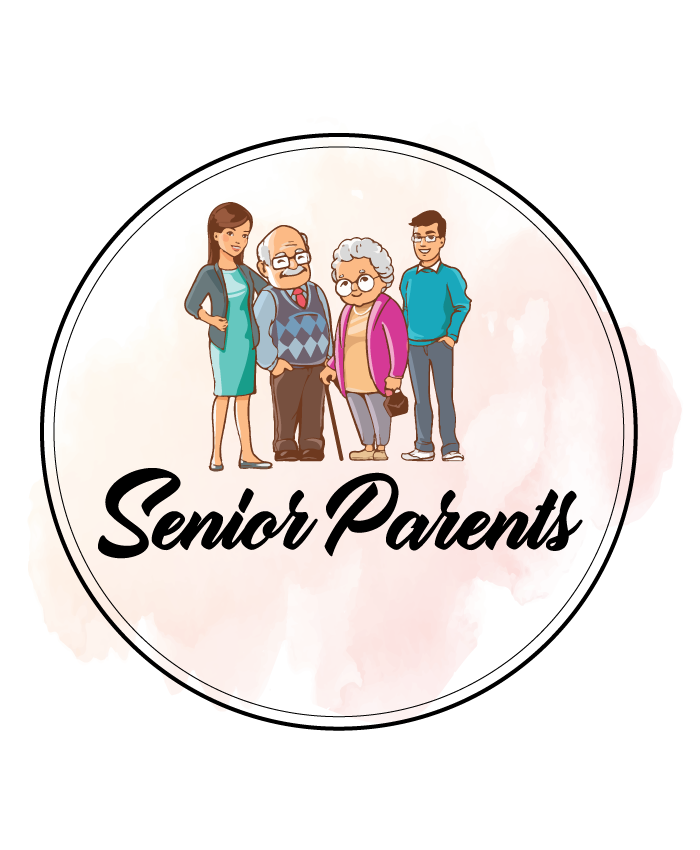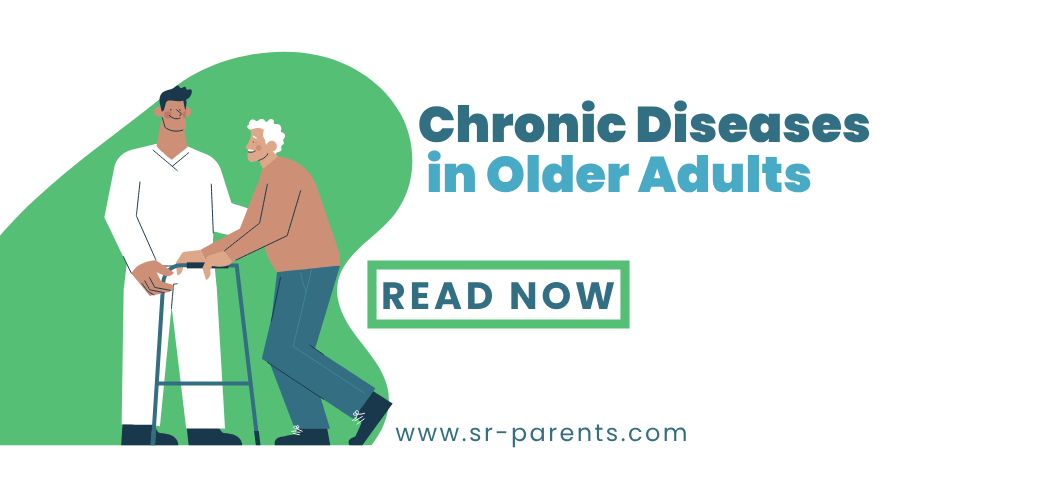“Explore comprehensive insights into managing chronic diseases in older adults.”
Entering the golden years of your life presents a unique set of joys and challenges. It often brings along unwelcome companions in the form of health issues. As dreams materialize, families grow, and life takes on new hues, it also extracts a toll—your youth.
Older people are more at risk of age-related conditions that usually do not affect young adults. Metabolism wanes, the immune system falters, and the risk of chronic diseases escalates.
Many factors play a role. Age, family history, and gender converge to weave a tale, making chronic diseases constant companions.

According to studies, 80% of those aged 65 or above have at least one chronic condition. In addition, 68% of older adults bear the weight of multiple chronic conditions.
Aging manifests in myriad ways—a subtle dimming of vision, a gradual loss of muscle strength, or the relentless rise of blood pressure. The journey often leads to the doors of a multispeciality hospital, seeking solace in medical expertise.
Let’s learn more about the most prevalent chronic diseases in older adults and how to live with one of these. We will also learn about risk factors and how to reduce the likelihood of a chronic illness.
Contents
What are Age-Related Chronic Conditions?

Age-related chronic conditions are health issues that become more prevalent with age. Often associated with the natural aging process, these conditions can impact physical and mental well-being. Some common examples of age-related chronic conditions include:
- Cardiovascular Diseases like hypertension (high blood pressure), atherosclerosis, and heart disease.
- Neurological Disorders like Alzheimer’s disease and other forms of dementia.
- Musculoskeletal Issues like arthritis and osteoporosis.
- Metabolic Conditions like type 2 diabetes.
- Cognitive impairment like macular degeneration, cataracts, and hearing loss.
- Prostate Cancer, particularly in men as they age.
Most Prevalent Chronic Diseases in Elderly Patients

Here are the most prevalent chronic diseases in older adults:
Chronic Kidney Disease
Many conditions or diseases can affect or damage your kidneys. With advancing age, the risk of kidney and urinary tract issues rises. It is more common in people aged 65 or older (34%) than in people aged 45–64 years (12%) or 18–44 years (6%).
This chronic disease causes a gradual decline in kidney function over time. Chronic kidney disease is also linked with other conditions, like cardiovascular disease.
Since kidney diseases can be severe, early detection and good management are essential. Regular blood tests and blood pressure checks can help catch any problems early.
Symptoms
Like osteoporosis, kidney disease is also silent as it often has no warning signs. Patients could lose up to 90 percent of kidney function without noticing symptoms. A few general signs of chronic kidney disease may have:
- high blood pressure
- blood in the urine
- changes in the urine amount and the number of times it is passed.
- differences in the urine color
- pain in the kidney area
How to Live with Chronic Kidney Disease?
Unfortunately, there is no cure for CKD or chronic kidney disease. However, you can relieve the symptoms and stop it from getting worse. While the treatment varies based on the stage of the disease, a few lifestyle changes can help:
- Take your prescribed dedications.
- Consult with your doctor before taking painkillers or supplements.
- Exercise boosts energy, strengthens bones, and reduces depression risk. Tailor activities to your CKD stage with your doctor’s guidance.
- Smoking worsens kidney disease, and alcohol can elevate blood pressure. Quit smoking and moderate your alcohol intake.
- Keep your BP lower than 140/90 mm Hg and target blood sugar range if you have diabetes.
- Limit salt, but explore flavorful options with herbs and spices. Focus on fruits, veggies, lean proteins, and carb-conscious choices.
- Eat berries, grapes, lean meats, eggs, and unsalted seafood into your diet.
- Choose water, clear diet sodas, and unsweetened tea to stay hydrated.

Chronic Obstructive Pulmonary Disease
Chronic Obstructive Pulmonary disease is a prevalent illness in older adults. It is more common in particularly those aged 65 years and above. It is most widespread in the Americas but least common in Southeast Asia and the Western Pacific regions.
The chronic condition in seniors doesn’t just affect their breathing. It also affects their overall quality of life.
Patients lose their ability to get around, socialize, and do daily activities. Chronic Obstructive Pulmonary disease primarily has two disorders: emphysema and chronic bronchitis.
These conditions aid the progressive respiratory challenges associated with COPD. Emphysema damages the air sacs, while chronic bronchitis causes inflammation in the bronchial tubes.
Symptoms
- Shortness of breath.
- Recurring chest infections
- Persistent chesty cough with phlegm that doesn’t go away
- Constant wheezing
How to Manage Chronic Obstructive Pulmonary Disease?
- Be consistent in taking your prescribed medicine, including inhalers, to prevent severe flare-ups.
- Check with your care team before taking over-the-counter remedies, including painkillers and supplements.
- Stopping smoking can slow down or prevent further lung damage.
- Regular exercise improves symptoms and enhances your quality of life.
- Lose weight through healthy diets and training. These can ease breathlessness.
- Check weather conditions, especially during cold spells or hot and humid periods. Ensure you have enough medication during weather-related symptom fluctuations.
- Avoid dusty places, fumes, smoke, and strong-smelling products. Exposure to such places can flare up COPD symptoms.
- Learn breathing techniques. Practice breathing control, relaxed deep breathing, and paced breathing to manage breathlessness.
Chronic Diseases in Older Adults / Video Credit: Electronic Caregiver
Geriatric Depression
Depression is a mental and emotional issue prevalent in older adults. While occasional “blue” moods are normal, persistent depression is not a natural part of aging.
Subsyndromal depression, more common in older adults, does not always meet the full criteria for major depression. However, it can get worse if left untreated.
As a chronic disease in older adults, it can diminish the quality of life and heighten the risk of suicide. Complications linked to aging, like immobility, isolation, and mortality, may contribute to depression.
Moreover, retirement, financial hardships, prolonged substance abuse, and the death of a loved one may also lead to depression.
Symptoms
Regardless of age group, symptoms of depression are the same:
- sadness
- feeling worthless
- fatigue
- lack of concentration
- restlessness
- crying spells
- apathy
- changes in appetite
- sleep problems
- thoughts of suicide
How to Manage Chronic Obstructive Pulmonary Disease?
- Consult with mental health professionals for proper diagnosis and treatment plans.
- Foster social connections with your friends and family. Join support groups to cut feelings of isolation and loneliness.
- Include gentle exercises or activities into your routine. Exercise promotes physical well-being and enhances mood.
- Follow your prescribed medication regimens, including antidepressants, as recommended by your healthcare providers.
- Consider therapy options, such as cognitive-behavioral therapy or counseling.
- Focus on proper nutrition, regular sleep patterns, and a balanced lifestyle.
Dementia and Alzheimer’s Disease

Alzheimer’s disease is one of the most common chronic diseases in older adults. As a progressive disease, it kicks off with mild memory loss. However, as it worsens, patients struggle to talk and respond to their surroundings.
As a neurodegenerative disease, it destroys brain cells. As a result, thinking ability and memory deteriorate over time. In addition, Alzheimer’s is not a natural part of aging and is irreversible.
Symptoms
- Memory decline that affects daily life.
- Getting lost in familiar places or repeating the same question.
- Struggles with everyday tasks at home, work, or during leisure.
- Reduced or poor judgment.
- Misplacing items and trouble retracing steps to find them.
- Changes in mood, personality, or behavior.
How to Live with Alzheimer’s Disease
- Talk about one thing at a time to make communication easier.
- Follow a daily schedule for stability and predictability.
- Stay in touch with family and friends for social support.
- Organize your living spaces to keep things simple and tidy.
- Use tools like calendars and reminders to help with organization.
- Stay active regularly to keep healthy and reduce stress.
Cancers
The word “cancer” is frightening when told by your doctor. Unfortunately, it is still a prevalent diagnosis, especially in older adults.
As you age, the risk of cancer increases. Research suggests that more than half of diagnoses occur in people aged 66 and above. Cancer begins when our cells get damaged. As we age, this damage can accumulate, increasing the risk of developing cancer over time.
Certain cancer types, like colon and prostate cancer, are more prevalent. However, early detection of such cancers is easy and offers the best chances of successful treatment.
In contrast, detecting and treating more elusive cancers, such as lung cancer, can be challenging. These types of cancers may not show noticeable symptoms in their early stages, making timely diagnosis more difficult.
Symptoms
- Unexplained pain that won’t go away
- Unexpected weight loss
- Skin changes, like darkening or itching
- Bowel or bladder habit changes
- Persistent fatigue or weakness
- Trouble swallowing or constant indigestion
- Changes in moles or skin spots
- Continuous coughing or hoarseness
- Changes in existing lumps or sores
Cardiovascular Disease
Adults aged 65 or above are more prone to cardiovascular disease. Age is an independent factor for chronic heart disease in older adults. Beyond age, issues like frailty, obesity, and diabetes can also heighten the risk.
Cardiovascular disease is a prime cause of disability and eroding the quality of life of older adults. Advancing age affects heart and blood vessel functionality. For example, with age, your heart cannot beat as fast during stress or physical activity as it did when you were young.
Moreover, a significant cause of heart disease is the pileup of fatty deposits in the artery walls over many years.
Symptoms of Cardiovas
- Numbness or tingling in shoulders, arms, neck, jaw, or back
- Breathlessness during activity, at rest, or while lying down
- Feeling lightheaded or dizzy
- Chest pain during physical exertion, easing with rest
- Cold sweats
- Nausea or vomiting
- Tiredness or fatigue
- Swelling in ankles, feet, legs, stomach, or neck
- Difficulty exercising or being physically active
- Challenges in performing regular activities
How to Manage Heart Disease?
- Be physically more active. Aim for at least 150 minutes of exercise each week, every day.
- Don’t sit for too long; take breaks throughout the day.
- Stop smoking to lower your chances of heart disease, stroke, and cancer.
- Embrace a heart-healthy diet low in saturated fats, added sugars, and salt.
- Eat heart-healthy by choosing foods low in bad fats, sugars, and salt.
- Keep your weight in check by balancing what you eat with physical activity.
- Control diabetes, high blood pressure, and high cholesterol with your doctor’s help.
- Regularly check cholesterol levels through fasting blood tests.
- Get regular blood tests to check cholesterol levels, including bad (LDL), good (HDL), and triglycerides.
- Learn ways to manage stress, like meditation and staying active.
Rheumatoid Arthritis

Rheumatoid arthritis (RA) is an immune system mix-up where the body mistakenly attacks its joints. This can cause swelling, pain, and stiffness in the joints.
While RA can start at any age, it’s more common in older adults, with a higher chance of onset in people in their 60s. When it shows up later in life, it is called Elderly Onset RA or EORA.
Experiencing rheumatoid arthritis in older age differs from its earlier onset. It also brings unique treatment challenges. Even though RA becomes more common with age, people who get it later in life only make up about one-third of those with the condition.
Symptoms
Elderly patients with RA may notice more than joint pain. Symptoms include:
- Muscle pain (myalgia)
- Fever
- Weight loss
- Anemia
How to Manage Rheumatoid Arthritis?
- Engage in gentle exercises like walking or jogging to keep your joints moving.
- Apply heat or cold packs to soothe swollen and painful joints.
- Manage weight to cut stress on joints.
- Eat anti-inflammatory diets rich in fruits, vegetables, and omega-3 fatty acids.
- Take your medications as directed by your doctor.
- Use assistive devices and techniques to protect joints during daily activities.
- Stay in touch with your doctor for check-ups and adjustments to your treatment plan.
- Try stress-reducing activities like meditation and deep breathing.
- Ensure enough rest and quality sleep for general well-being.
Coronary Heart Disease
Coronary Heart Disease is a prevalent type of heart disease in older adults. As you age, the risk of developing CHD increases substantially.
This condition, often called atherosclerosis, occurs when plaque builds up in your heart’s arteries. This accumulation disrupts blood flow, leading to chest pain and shortness of breath.
If you are 65 or older, you are at a higher risk. Lifestyle matters, so manage things like high blood pressure and cholesterol.
Symptoms
- Pain in chest
- tightness
- heaviness
- squeezing
- burning
How to Manage?
- Engage in physical activity like walking or jogging.
- Follow a diet low in saturated fats, sugars, and salt.
- Keep weight in check to reduce stress on the heart.
- Stop smoking to cut heart disease risk.
- Keep your alcohol intake moderate to avoid excess.
- Attend routine medical check-ups for early detection and management.
- Manage and watch your blood pressure to prevent heart strain.
High Cholesterol
High cholesterol is among the most prevalent chronic diseases in older adults. The condition contributes to various cardiovascular issues.
Cholesterol is a fatty substance in the body’s cells and certain foods. It has two main types: low-density lipoprotein (LDL) and high-density lipoprotein (HDL).
LDL is often called “bad” cholesterol as it can accumulate on the walls of arteries, leading to plaque formation and atherosclerosis. In contrast, HDL is “good” cholesterol because it helps remove LDL from the bloodstream.
High cholesterol itself does not cause noticeable symptoms. You may not notice anything wrong until it leads to other issues in your body. It raises the risk of conditions like peripheral artery disease, high blood pressure, and strokes. Many people with diabetes also have high cholesterol.
How to Manage?
- Stop smoking.
- Avoid or lower your alcohol consumption.
- Stay active and exercise.
- Aim to maintain a healthy weight.
- Avoid eating saturated and trans fats.
Wrapping Up: Chronic Conditions in Elderly Patients

Taking care of chronic diseases in older adults is like solving a puzzle with many pieces. We must look at the big picture and consider everything that helps seniors stay healthy and happy.
Prevention, early detection, and management are essential to improve life for older adults. Moreover, it is vital for everyone – doctors, families, and communities – to work as a team.
Healthy habits, strong connections with doctors, and new technologies can all help. Let’s join hands to ensure older adults live longer and enjoy a good and fulfilling life.
FAQs
What chronic conditions in older adults can stop you from driving?
Certain chronic conditions can affect your ability to drive safely. These include vision problems, epilepsy, severe heart issues, and uncontrolled diabetes. In addition, dementia, limited mobility, and psychiatric conditions can also be a problem.
These conditions impact your judgment, reaction time, or physical abilities needed for driving. Rules about driving with health conditions can vary. Sometimes, healthcare providers or authorities may need to assess if you are safe to go.
Are there any home remedies for treating cardiovascular disease?
Cardiovascular disease in older adults is a severe health concern. And home remedies alone can’t replace proper medical care for a chronic disease.
Cardiovascular problems need extended medical help. However, adopting a heart-healthy lifestyle at home helps alongside medical treatments.
Eat well with fruits, veggies, and lean proteins. Exercise with walks or swims and maintain a healthy weight. In addition, quit smoking and cut or limit alcohol. While these habits support heart health, always consult a doctor for personalized advice.
What you should avoid in high blood pressure?
Avoid excessive salt intake to manage high blood pressure, as it can raise blood pressure. In addition, limit processed and packaged foods, as they contain high sodium levels. Moderate alcohol consumption can contribute to elevated blood pressure.
Excessive caffeine intake is also harmful and may cause a temporary spike in blood pressure. Avoid smoking, as it damages blood vessels and can raise blood pressure.
Gain a healthy weight through balanced eating and regular exercise. Manage stress through relaxation techniques.
Is joint pain among chronic diseases in older adults?
Joint pain is not a chronic disease by itself. Instead, it is a symptom of various conditions.
Chronic conditions like osteoarthritis or rheumatoid arthritis cause persistent joint pain. Gout, another arthritis type, results in sudden, severe pain. Though joint pain is not chronic, managing these conditions is crucial for long-term joint health.
Welcome to Senior Parents!
Welcome to Senior Parents. A dedicated space for families working together to provide the best care for aging parents and grandparents!
Our platform is a treasure trove of practical tips and insightful advice to navigate the unique challenges of elderly care.
From fostering a supportive environment to making informed healthcare decisions, we are here to guide you every step of the way.
Join our community and connect with like-minded families on social media!
Follow us on social platforms to stay updated with the latest tips, engage in meaningful discussions, and share your experiences.
Let’s create a robust and supportive network to ensure our dear ones age with joy and dignity.
Join us in this journey of family, care, and compassion!
Facebook: www.facebook.com/sr.parents
Insta: www.instagram.com/seniorparents
Pinterest: www.pinterest.com/seniorparents
Twitter: twitter.com/senior_parents





